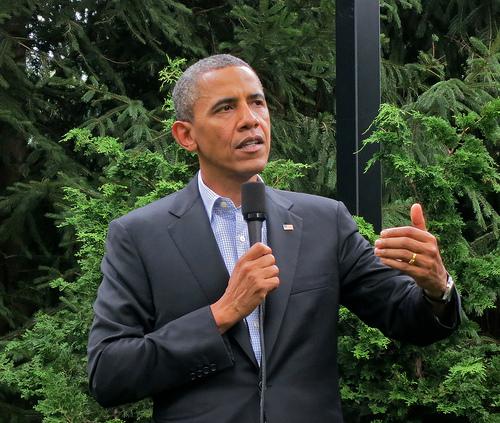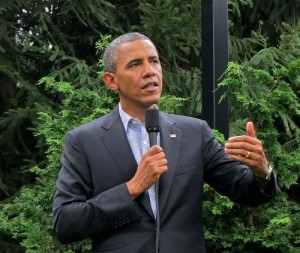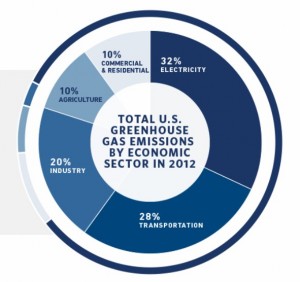June 2, 2014 – Executive action seems the only way these days to get the United States on a carbon footprint reduction plan. With today’s announcement by President Obama focused on reducing carbon pollution and fighting climate change we may yet begin to see progress on this critical human and world issue.
So what did the President announce? What are called a series of executive actions focused on preparing Americans for climate change impacts while setting national carbon pollution limits by reducing CO2 emissions from existing power plants across the United States. These are Environmental Protection Agency guidelines (contained in a 645 page EPA document) to be administered and monitored in every American state. They govern existing fossil-fuel-fired power plants. The guidelines will receive hearings this summer giving the public and industry stakeholders the opportunity to provide comments and data in response to the stated targets.
The objective is to reduce America’s greenhouse gas (GHG) emissions, primarily CO2 coming from power plants by 30% from 2005 levels. Today, 32% of all GHG emissions come from power generation and 82% of what is produced in CO2. With these reduction targets to be met by 2030 the net benefit calculated by the EPA for both climate and health will be worth worth between $48 and $82 billion U.S. annually.
Does this mean the end of coal-based energy production? No. The EPA believes that by 2030 30% of U.S. power will still come from coal.In 2013 that number was close to 40%. How is it possible then to reduce CO2 with so much energy production still coming from coal? The EPA believes that lower-emitting technologies deployed in these power plants, upgrades to existing electricity infrastructure, more efficient use of electricity by industry and consumers, conservation and carbon sequestration projects will make it possible to still use coal while achieving the overall reduction goal.
States are to receive individual emission reduction targets reflecting the fuel mix used within the existing power generation infrastructure. But no state is specifically told how to meet its goal. That is up to state planning “consistent with the EPA guidelines” which are laid out for the states to use in creating compliance strategies. States can go it alone or collaborate with others.
Why are power plants the target of this executive action? Because as the executive action guidelines state, fossil fuel power plants are “by far, the largest emitters of GHGs, primarily in the form of CO2, among stationary sources in the U.S.” As proof, just last week I wrote about two of those producers, AEP and Duke, who collectively contribute over 275 million tons of CO2 to the atmosphere annually.
Targeting coal-fired power plants recognizes that these facilities are sites that by 2025 will average 49 years in age. About 20% of them will exceed 60 years in age. So making plans to phase them out, upgrade their technology or rebuild them entirely seems logical.
As in the acid rain programs developed in the 1990s compliance with GHG “can be monetized such that it is factored into power sector economic decision making in ways that reduce the cost of controlling pollution.” Does that mean a carbon tax or a carbon trading market? It certainly puts a price on carbon but we will see what falls out from the public and stakeholder discussions in the coming weeks.
It is good to read in these guidelines words like “state plans must establish standards of performance that reflect the degree of emission limitation.” I state this because guidelines is not a word I associate with enforceable compliance. A framework of components for each state plan is provided. In addition to achieve emission reduction the EPA offers a number of “building blocks” for power generators to implement:
- Developing technology that reduces the unit of carbon intensity for every unit of power generated.
- Introducing less carbon-intensive substitutes for power generation in existing power plants.
- Developing zero-carbon generating capacity as an alternative to coal-fired power plants.
- Reducing demand from consumers and industry by improved energy efficiency.
With state oversight and policies conducive to help the utilities achieve these blocks the EPA believes the reduction objective of 30% can be achieved in 2030. In preparation for the announcement today President Obama released a video on Saturday, May 31st that you can watch here. It talks about the impact of carbon pollution on children’s health as well as the most recent reports that show that climate change is impacting the United States now.












Obama has zero knowledge of climate science, he just want’s to appease his radical enviros for the campaign funds and votes he got through them.
His claims are not based on science but ideology and the false claims of the IPCC based on climate models. He insists this is for the future of the planet, but last year the government’s own climate observers at NOAA reported a record low number of tornadoes and the longest pause ever in the occurrence of big hurricanes. Despite increasing levels of CO2, temperatures show almost 2 decades of no increases. Data shows increasing polar sea ice and historical facts show cycles of droughts and floods as long as a thousand years ago and more, long before reliance on fossil fuels.
Environmental extremists are trying to attribute every major weather event, regular occurrences since the formation of this violent planet Earth, to human-made climate change, claims that are not reasonable, not science, and not honest. Obama carries the water for these extremists as he carries the cash donations from them.
These new draconian regs., that are way beyond reasonable measures, based on pseudo science and unverified claims of the EPA, would only effect 1% of the worlds emissions while costing the economy over half a trillion dollars that would adversely effecting mostly the poorer folks of the US as it would raise the price of everything, as everything depends largely on electricity costs.
This is just one of Obama’s fascist methods of increasing government power and cronyism through dictatorial executive mandates.
You certainly have a point of view about climate change that is far different than the science. And your view of what President Obama is doing, suggesting that he is making these decisions in a vacuum, doesn’t speak to the facts. The IPCC reports are a compilation of evidence gathered by thousands of scientists and include millions of data points. They are not making this stuff up. But I think you believe they are.
[…] American President Announces Carbon Pollution Reduction Targets https://www.21stcentech.com/american-president-announces-carb…n-targets/ […]